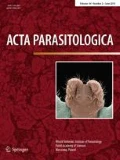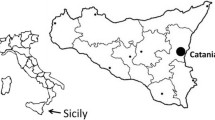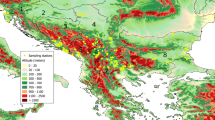Abstract
Purpose
Sand flies are vectors of medical and veterinary concern, responsible for the transmission of Leishmania parasites. These invertebrates are widely distributed throughout the world and their abundance and diversity is dependent on several biotic and physical factors. Based on the epidemiological importance of these insects, the aim of this study was to assess the sand fly fauna of a new area of occurrence of leishmaniasis.
Methods
From October 2018 to September 2019, samplings were performed using CDC light traps at six different collection points located in a high altitude area in the municipality of Garanhuns, Northeastern Brazil. Geographic coordinates were recorded using the satellite remote sensing Global Positioning System (GPS) Garmin Etrex20. The spatial distribution of sand flies was evaluated using kernel density estimation (KDE). Engorged females (n = 12) were molecularly processed to search for Leishmania DNA.
Results
A total of 138 sand fly specimens were collected during the study period, with 100% (138/138) identified as Lutzomyia evandroi. Climatic conditions did not influence the number of sand flies (males and females) collected monthly, but a statistically significant difference was observed between the number of specimens and different collections points. The kernel map showed a heterogeneous spatial distribution of sand flies in the municipality of Garanhuns with a hotspot in the south of the region.
Conclusion
Data presented herein are pivotal in filling the gap on the epidemiology of leishmaniasis in this high altitude area, serving as an alert to local health authorities. It also indicated that the putative role of L. evandroi in the transmission of Leishmania parasites should be clarified.



Similar content being viewed by others
References
Maroli M, Feliciangeli MD, Bichaud L, Charrel RN, Gradoni L (2013) Phlebotomine sand flies and the spreading of leishmaniases and other diseases of public health concern. Med Vet Entomol 27:123–147. https://doi.org/10.1111/j.1365-2915.2012.01034.x
Andrade ARO, Dorva MEMC, Andrade SMO, Marques A, Silva BAK, Andreotti R (2012) Phlebotomine fauna in the Ponta Porã city: epidemiological importance in border line between Brazil and Paraguay. Asian Pac J Trop Dis 2:362–366. https://doi.org/10.1016/S2222-1808(12)60079-6
Yared S, Gebresilassie A, Akililu E, Deribe K, Balkew M, Warburg A, Hailu A, Gebre-Michael T (2017) Diversity and altitudinal distribution of phlebotomine sand flies (Diptera: Psychodidae) in visceral leishmaniasis endemic areas of northwest Ethiopia. Acta Trop 176:1–10. https://doi.org/10.1016/j.actatropica.2017.07.008
World Health Organization—WHO (2019) Leishmaniasis. World Health Organization Web. https://www.who.int/en/news-room/fact-sheets/detail/leishmaniasis. Accessed 30 Jun 2019
Shimabukuro PHF, Andrade AJ, Galati EAB (2017) Checklist of American sand flies (Diptera, Psychodidae, Phlebotominae): genera, species, and their distribution. ZooKeys 660:67–106. https://doi.org/10.3897/zookeys.660.10508
Costa HNC (2008) Characterization and speculations on the urbanization of visceral leishmaniasis in Brazil. Cad Saúde Pública 24:2959–2963. https://doi.org/10.1590/S0102-311X2008001200027
Guimarães VCFV, Costa PL, Silva FJ, Silva KT, Silva KG, Araújo AIF, Rodrigues EHG, Brandão-Filho S (2012) Phlebotomine sand flies (Diptera: Psychodidae) in São Vicente Férrer, a sympatric area to cutaneous and visceral leishmaniasis in the state of Pernambuco, Brazil. Rev Soc Bras Med Trop 45:66–70. https://doi.org/10.1590/S0037-86822012000100013
Santos JML, Dantas-torres F, Mattos MRF, Lino FRL, Andrade LSS, Souza RCA, Brito FLC, Brito MEF, Brandão-Filho SP, Mattos LS (2010) Prevalência de anticorpos anti-Leishmania spp. em cães de Garanhuns, Agreste de Pernambuco. Rev Soc Bras Med Trop 43:41–45. https://doi.org/10.1590/S0037-86822010000100010
Lins TNB, Souza IB, Barros GMMR, Santos CVB, Silva RP, Alves LC, Carvalho GA, Ramos RAN (2018) Seroprevalence and spatial distribution of canine leishmaniasis in an endemic region in Brazil: how has the situation changed after 10 years? Rev Soc Bras Med Trop 51:680–682. https://doi.org/10.1590/0037-8682-0087-2018
Sistema Nacional de Agravos e Notificações—SINAN (2019) Portal da saúde. DATASUS Web. https://www2.datasus.gov.br/DATASUS/index.php?area=0203&id=29878153. Accessed 19 Dec 2019
Instituto Brasileiro de Geografia e Estatística – IBGE (2019) Diretoria de Pesquisas, Coordenação de População e Indicadores Sociais, Estimativas da população residente. Portal do Governo Brasileiro Web. https://cidades.ibge.gov.br/brasil/pe/garanhuns/panorama. Accessed 05 Out 2019
Barbosa VV, Souza WM, Galvinício JD (2016) Análise da variabilidade climática do município de Garanhuns, Pernambuco–Brasil. Rev Bras Geogr Física 9:353–367. https://doi.org/10.26848/rbgf.v9.2.p353-367
Andrade ARS, Paixão FJR, Azevedo CAV, Gouveia JPG, Oliveira Júnior JAS (2008) Estudo do comportamento de períodos secos e chuvosos no município Garanhuns, PE, para fins de planejamento agrícola. PA&T 1:54–61
Andrade-Lima D (1982) Present day forest refuges in Northeastern Brazil. In: Prance GT (ed) Biological diversification in the tropics. Columbia University Press, New York, pp 245–254
Young DG, Duncan MA (1994) Guide to the identification and geographic distribution of Lutzomyia sand flies in Mexico, the West Indies, Central and South America (Diptera: Psychodidae). Mem Am Entomol Inst 54:1–881
Cortes S, Rolão N, Ramada J, Campino L (2004) PCR as a rapid and sensitive tool in the diagnosis of human and canine leishmaniasis using Leishmania donovani s.l.-specific kinetoplastid primers. Trans R Soc Trop Med Hyg 98:12–17. https://doi.org/10.1016/s0035-9203(03),00002-6
de Bruijn MHL, Barker (1992) Diagnosis of New World leishmaniasis: specific detection of species of the Leishmania braziliensis complex by amplification of kinetoplast DNA. Acta Trop 52:45–58. https://doi.org/10.1016/j.actatropica.2013.01.011
Sherlock IA (1996) Ecological interactions of visceral leishmaniasis in the State of Bahia, Brazil. Mem Inst Oswaldo Cruz 91:671–683. https://doi.org/10.1590/S0074-02761996000600003
Sales KGS, Miranda DEO, Costa PL, Silva FJ, Figueredo LA, Brandão-Filho SP, Dantas-Torres F (2019) Home sweet home: sand flies find a refuge in remote indigenous villages in north-eastern Brazil, where leishmaniasis is endemic. Parasit Vectors 12:118. https://doi.org/10.1186/s13071-019-3383-1
Nery LCR, Lorosa S, Franco AMR (2004) Feeding preference of the sand flies Lutzomyia umbratilis and L. spathotrichia (Diptera: Psychodidae. Phlebotominae) in an urban forest patch in the city of Manaus, Amazonas, Brazil. Mem Inst Oswaldo Cruz 99:571–574
Miranda DEO, Sales KGS, Faustino MAG, Alves LC, Brandão-Filho SP, Dantas-Torres F, de Carvalho GA (2015) Ecology of sand flies in a low-density residential rural area, with mixed forest/agricultural exploitation, in north-eastern Brazil. Acta Trop 146:89–94. https://doi.org/10.1016/j.actatropica.2015.03.011
Agra MCR, Costa PL, Duque AES, Soares ENL, Alves LC, Ramos RAN, de Carvalho GA (2016) Sands flies (Diptera: Psychodidae) in an urban area of Northeastern Brazil. Rev Soc Bras Med Trop 49:698–702. https://doi.org/10.1590/0037-8682-0147-2016
Silva APO, Miranda DO, Santos MAB, Guerra NR, Marques SR, Alves LC, Ramos RAN, de Carvalho GA (2017) Phlebotomines in an area endemic for American cutaneous leishmaniasis in northeastern coast of Brazil. Rev Bras Parasitol Vet 26:280–284. https://doi.org/10.1590/S1984-29612017038
Gouveia C, Oliveira RM, Zwetsch A, Motta-silva D, Carvalhob M, Santana AF, Rangel EF (2012) Integrated tools for American Cutaneous Leishmaniasis surveillance and control: intervention in an endemic area in Rio de Janeiro, RJ, Brazil. Interdiscip Perspect Infect Dis. https://doi.org/10.1155/2012/568312
Camargo-Neves VLF, Katz G, Rodas LAC, Poletto DW, Lage LC, Spínola RMF, Cruz OG (2001) Utilização de ferramentas de análise espacial na vigilância epidemiológica de leishmaniose visceral Americana—Araçatuba, São Paulo, Brasil, 1998–1999. Cad Saúde Pública 17:1263–1267. https://doi.org/10.1590/S0102-311X2001000500026
Costa PL, Dantas-Torres F, da Silva FJ, Guimarães VCFV, Gaudêncio K, Brandão-Filho SP (2013) Ecology of Lutzomyia longipalpis in an area of visceral leishmaniasis transmission in north-eastern Brazil. Acta Trop 126:99–102. https://doi.org/10.1016/j.actatropica.2013.01.011
Almeida PS, Minzão ER, Minzão LD, Silva SR, Ferreira AD, Faccenda O, Andrade-Filho JD (2010) Aspectos ecológicos de flebotomíneos (Diptera: Psychodidae) em área urbana do município de Ponta Porã, Estado de Mato Grosso do Sul. Rev Soc Bras Med Trop 43:723–727. https://doi.org/10.1590/S0037-86822010000600025
Silva JAO, Silva FJ, Macedo LO, Santos CVB, Alves LC, Ramos RAN, Faustino MAG, de Carvalho GA (2019) Sand flies in an endemic area for Visceral Leishmaniasis in Northeastern Brazil. Braz J Vet Parasitol 28:1–5. https://doi.org/10.1590/S1984-29612019073
Carvalho MR, Lima BS, Marinho-Júnior JF, Silva FJ, Valença HF, Almeida FA, Silva AL, Brandão-Filho SP (2007) Phlebotomine sand fly species from an American visceral leishmaniasis area in the Northern Rainforest region of Pernambuco State, Brazil. Cad Saúde Pública 23:1227–1232. https://doi.org/10.1590/S0102-311X2007000500024
Colacicco-Mayhugh MG, Masuoka PM, Grieco JP (2010) Ecological niche model of Phlebotomus alexandri and P. papatasi (Diptera: Psychodidae) in the Middle East. Int J Health Geogr 9:1–9. https://doi.org/10.1186/1476-072X-9-2
Neitzke HC, Scodro RB, Castro KR, Sversutti AC, Silveira TG, Teodoro U (2008) Research of natural infection of phlebotomines for Leishmania, in the State of Paraná. Rev Soc Bras Med Trop 41:17–22. https://doi.org/10.1590/s0037-86822008000100004
Acknowledgements
This article is based on a Masters dissertation (Postgraduate Program in Animal Bioscience), developed at the Federal Rural University of Pernambuco, with support from a fellowship from Coordenação de Aperfeiçoamento de Pessoal de Nível Superior (CAPES). The authors would like thanking Dr. Carlos A.S. Leal (Federal Rural University of Pernambuco) for his support on the molecular analysis.
Author information
Authors and Affiliations
Corresponding author
Ethics declarations
Conflict of Interest
On behalf of all authors, the corresponding author states that there is no conflict of interest.
Additional information
Publisher's Note
Springer Nature remains neutral with regard to jurisdictional claims in published maps and institutional affiliations.
Rights and permissions
About this article
Cite this article
Ubirajara Filho, C.R.C., da Silva Sales, K.G., Lima, T.A.R.F. et al. Lutzomyia evandroi in a New Area of Occurrence of Leishmaniasis. Acta Parasit. 65, 716–722 (2020). https://doi.org/10.2478/s11686-020-00215-0
Received:
Accepted:
Published:
Issue Date:
DOI: https://doi.org/10.2478/s11686-020-00215-0




